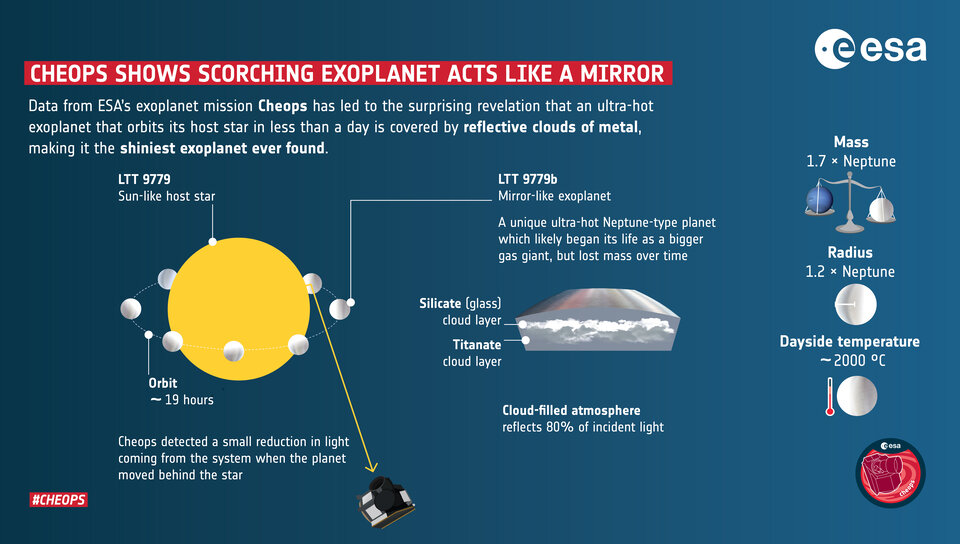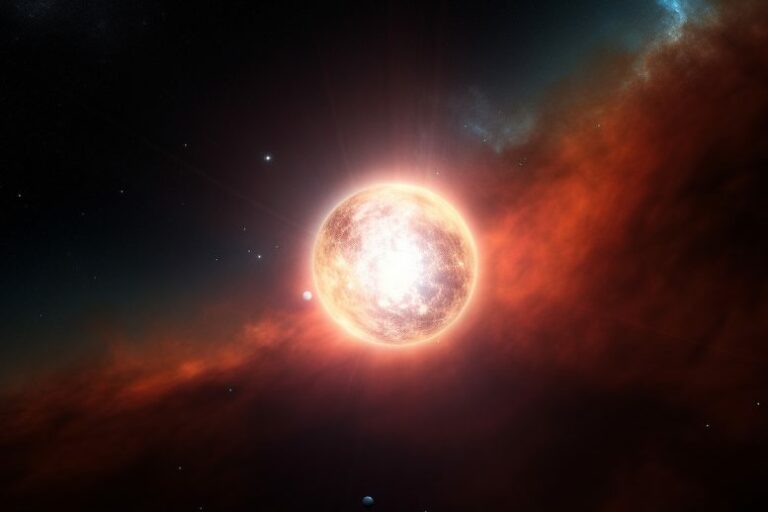Blazing Brightest Exoplanet Discovered, Reflecting 80% of Its Star’s Light Thanks to Metallic Clouds
LTT9779 b reflects 80% of its star’s light, making it as bright as Venus, thanks to metallic clouds.
Scientists have found a new exotic exoplanet, LTT9779 b, which is 80 percent albedo, or reflects 80 percent of its star’s light. This planet is surrounded by magnetic silicate and metal clouds such as titanium and give the planet a ‘mirror-like’ appearance. It is said to have a surface temperature of 2000°C, normally a condition that would forbid clouds to form; but metal vapors condense rather like steam on the bathroom mirror. LTT9779 b disagrees with theories existing at the moment, because it is situated in the ‘hot Neptune desert,’ which means that the planet cannot maintain its atmosphere according to its size.
Thus, Venus in spite of its thick cloud cover appears brightest in the sky except Moon because it reflected about 75% of total sunlight which reaches the planet, while, Earth reflecting only about 30% of total sunlight.
For the first time, astronomers have identified an exoplanet as bright as Venus: LTT9779 b. Precise Transit Photometry from the ESA Cheops mission seems to indicate that the planet reflects 80% of the star’s light.
Cheops’ high accuracy measurements were carried out as a part of a scheduled follow-up to the initial identification and characterization of the planet by NASA’s TESS mission as well as different ground based observatories such as ESO’s HARPS in Chile.
LTT9779 b, which is about as big as Neptune, is now the largest “mirror” in the Universe. This high degree of reflectivity is attributed to the silicate metallic clouds that cover it including titanium mixed with sand and glass.
“Suppose you had a hot planet, moving near its star with thick layers of metals above it and tiny titanium beads falling like rain,” explains James Jenkins, an astronomer at Diego Portales University and CATA (Santiago, Chile), an author of the scholarly paper based on this discovery, which was published in the Astronomy & Astrophysics scientific journal.

A sky full of metallic clouds
In technical terms ‘albedo’ represents the ratio of reflectivity in an object. They are reflectance which is also often referred to as albedo and most planets have low albedo either because their atmosphere is absorbent or the surface is dark or rough. However, cold ice world and the planets with reflective cloud layer such as Venus are exceptions.
The high albedo reasonably came as a shock despite the fact that one side of the planet that faces the star can reach temperatures of up to 2000° C. As the temperature rises above 100 C centigrade, water clouds can not occur and the climate of the given planet will be too hot for the metal or glass clouds to exist.
“We slowly started wondering whether cloud formation should be looked at in the same way as the condensation which occurs in a bathroom after steaming shower,” responds Vivien Parmentier, a researcher at Observatory of Côte d’Azur at France as well as a co-author to the work. Vivien explains: It is the same principle as when one tries to steam up a bathroom making the water condense or continuing to run hot water until the clouds appear because the air is already saturated with the vapor and cannot contain any more: The same applies to LTT9779 b and its metallic clouds, despite the observed high temperature of the current atmosphere filled with silicate and metals vapors.
The planet that should not exist
It’s not just that LTT9779 b is a bright exoplanet, but it is also actually bright. It is an ‘ultra-hot Neptune’ by size and temperature but no other ‘hot Neptune,’ analogs of similar size or mass are found as close to the host star, which puts it in the ‘hot Neptune desert.
LTT9779 b has a radius 4 units of measurement. Twice the size of our planet, it has a day and year 7 times shorter than Earth’s, to be precise. Other known planets that take less than a day to orbit the star are ‘hot Jupiters’, which are gaseous with minimum radius of 10 times the earth or planets with a radius of less than 2 times that of the earth.
“It is a planet which does not need to be there,” comments Vivien Parmentier. “The sort of planet it gives off we would feel should have been stripped of its atmosphere by the star leaving only rock behind it. ”
Sergio Hoyer from the Marseille Astrophysics Laboratory that led the research also weighs in: “We hypothesize that these metallic clouds contribur to the planet’s NICNAS in the scalding Neptune desert Theplanet does not overheat and fails to evaporate because the clouds reflect stellar irradiation. At the same time, its high metallicity makes the planet and its atmosphere denser hence harder for the star to strip. ”
Observing an exoplanet when it is concealed
To identify the features of LTT9779 b, ESA’s characterizing exoplanets mission Cheops watched the planet as it passes behind the star it orbits. That is why when light reflects from the planet the total light from the star and from the planet is definitely brighter right before the planet ‘shuts the door. ’ How much light the planet reflects is determined by the variation in visible light captured before the planet is occulted and that after the occultation.
This observation required a high precision as well as constant coverage, which was provided by Cheops thanks to the presented attitude control and pointing accuracy. “The tiny change in the star’s signal as the planet passes in front of the star or during the eclipse could only be measured by Cheops, says Sergio Hoyer.
Maximilian Günther, ESA’s Cheops project scientist, adds: “Cheops is the first space astronomy mission designed for the follow-up and characterization of known exoplanets. Different from wide-field survey missions, designed for planetary system detection, Cheops can rapidly point at interesting objects and provide the level of light curve photometry and photometric precision which are often difficult or impossible to obtain through other means. ”
Productivity in the study of exoplanets can be obtained using multiple instruments that would give a systematic view of a subject. “LTT9779 b is well-suited for further study with the current functionalities of Hubble and further improvements with the James Webb Space Telescope,” adds Emily Rickman, an ESA scientific operations scientist. “It will give us the opportunity to observe this exoplanet with more additional parameters, such as infrared or UV light to study it’s atmosphere in more detail. ”
The forecast as to what is next in exoplanet research is rather optimistic, because Cheops is the first of three dedicated exoplanet missions. Plato is planned to be launched in 2026 aimed on studying Earth-like planets in the zones of their potential habitability. This will be done by Ariel, which is scheduled to launch in 2029 for the research on exoplanets’ atmospheres.
S. Hoyer et al. (2023) presented an article on the unusually high albedo of LTT 9779 b discovered by Cheops. doi: https://www.aanda.org/10.1051/0004-6361/202346117.
Do not forget to share your opinion with us to provide you with the best posts !




0 Comments